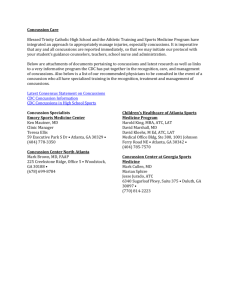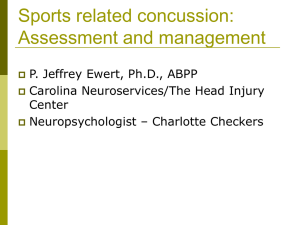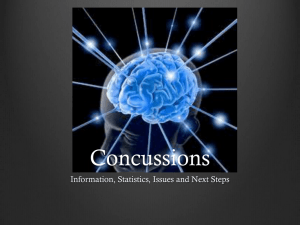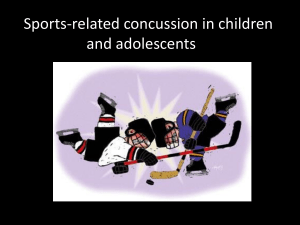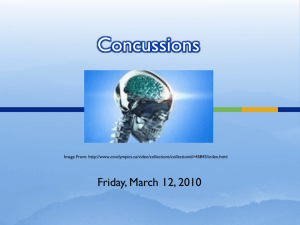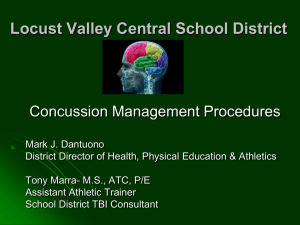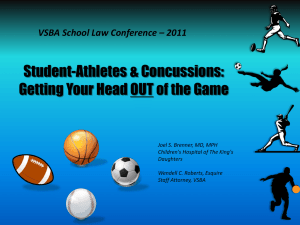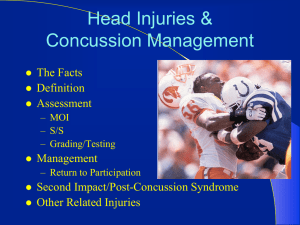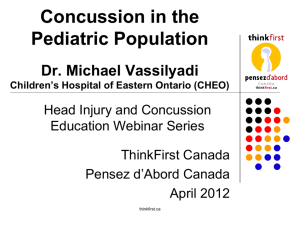You*ve had a concussion! How to return a player to the
advertisement
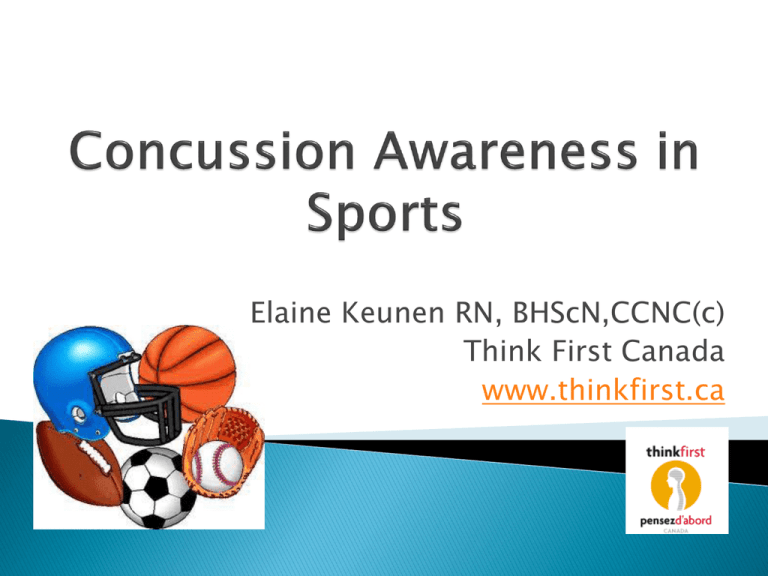
Elaine Keunen RN, BHScN,CCNC(c) Think First Canada www.thinkfirst.ca The brain weighs about 3 lbs. The brain uses 30% of the oxygen and energy in your body. The brain is encased by a skull with the thickness of three pennies. The brain is not fully developed until about 25 years of age. Frontal-personality, moral, ethical and social values, abstract thinking, long term memory, motor strip for the opposite side of the body Parietal-sensory strip for the opposite side of the body, two point discrimination, reconigition of object by size, shape weight and texture, body part awareness Temporal-hearing, senses of taste and smell, integrates sounds, thoughts and emotions Occipital-vision, reading comprehension, and visual recognition of objects There are 100 billion cells in the brain. Most of the cells are called neurons. Neurons are basically like on/off switches of a light switch. Neurons are either resting or shooting an electrical impulse down a wire called an axon. Each of the neurons spit out chemicals that trigger other neurons. A concussion is a brain injury that results from a hit to the head, face or jaw or even elsewhere on the body. It may also result from a whiplash effect to the head and neck. There are 100 billion neurons (brain cells) and 1000 axons which connect each neuron in our brain, which control all aspects of life. A concussion disrupts those pathways and can be catastrophic” “ John Kumpf, executive director of the Ontario Brain Injury Association Headache Dizziness Feeling Dazed Seeing Stars Sensitivity to Light Ringing in the Ears Tiredness/Fatigue Nausea/Vomiting Irritability Confusion/Disorientation Poor Balance Slow or Slurred Speech Poor Concentration Delayed responses to questions Vacant Stare Decreased playing ability Unusual emotions, personality changes and inappropriate behaviour Why players should not play until symptoms have subsided. Second-impact syndrome (SIS) is an extremely rare condition in which the brain swells rapidly and catastrophically after a person suffers a second concussion before symptoms from an earlier one have subsided. This deadly second blow may occur days or weeks after an initial concussion,[1] and even the mildest grade of concussion can lead to SIS.[2] Unfortunately there is no definite test or scan that can determine that a concussion has occurred. It is based on a judgment call considering the situation and the signs/symptoms that one is exhibiting. Researchers are finding that females are two to five times more likely to suffer a concussion- belief is that hormones and the strength of neck muscles play a role. Their symptoms generally are more severe, and females generally take longer to recover from concussions, on average a week longer than the male brain. Is a set of symptoms that a person may experience for weeks, months, or occasionally years after a concussion It is not known what causes PCS to occur or persist, or why some people who suffer a concussion develop PCS while others do not Occurs in about 10% of the people who have suffered a concussion Headaches - the most common symptom Dizziness-the second most common symptom Sensitivity to noise and light Blurred vision or double vision Ringing in the ears (tinnitus) Loss of hearing Fatigue, sleeplessness or insomnia Problems with concentration and memory Irritability, depression and anxiety or changes in personality It is believed that some individuals have a susceptibility towards concussions so players that have had a one or more concussions should be watched closely. “When it comes to protection in the sport of hockey, the helmet is an athlete’s most vital piece of equipment.” Mark Messier-NHL hockey icon and spokesperson for The Messier Project with Cascade Sports Helmets are proven to significantly reduce the number of head injuries but the proper use and fit is important. However, wearing a helmet does not make a player invincible to concussions. You should be only able to get one finger between the chin strap on a helmet and the chin. Helmets must fit properly to be effective! *REMOVE THE PLAYER FROM THE GAME •Do not leave the player alone-monitor signs and symptoms •Do not administer medication •Inform the coach and parent or guardian of the injury •The player should be evaluated by a medical physician Today's players are better trained and faster on their skates then ever before, therefore the acceleration of hits have increased. This is because of improved ice conditions and better quality skate technology. “The faster the acceleration, the greater the impact the internal organs (including the brain) will suffer and the more shaken-up a player will be.” Alain Hache author of ‘The Physics of Hockey’ Harder and Larger Protective Equipment Just about every sport has a potential for concussions to occur. Hockey, football, soccer, basketball, rugby are all high risk sports for concussions. Surprisingly the most concussions occur in football and boys and girls soccer at a high school level. (This is according to a study from the Center for Injury Research and Policy at Nationwide Children's hospital in Columbus Ohio) A Little Known Fact About Hockey \ The first testicular guard "Cup" was used in hockey in 1874 and the first helmet was used in 1974. It took 100 years for us to realize that the brain is also important. Quote from Paul Dennis 2010 HOCKEY CANADA CONCUSSION SEMINAR Elaine Keunen RN, BHScN, CCNC(c) Think First Canada www.thinkfirst.ca No activity, only complete rest! Only precede to step 2 when symptoms are gone! Light aerobic exercise, such as walking or stationary cycling. Monitor for signs and symptoms. No resistance training or weight lifting during this step Sport specific activities and training. Begin player back on the ice skating Drills without body contact. May add some light resistance training and progress to weight training. Begin drills with body contact Game Play! The minimum length of time between each return to play steps should be 1 day. Therefore no player should be returning to game play before about one week after suffering a concussion. Make sure that the helmet is in a good state of repair with no missing screws or pieces of internal foam. Carry a screwdriver and extra helmet screws in your hockey bag or trainers kits to be prepared for repairs. Replace your mouth guard each season, when worn from chewing and with changes in teeth i.e.. new molars etc. They want a concussion or a hockey injury about as much as you do. You got to be respectful to get respect! Be aware of where your body is hitting and keep control of your stick! THIS IS YOUR RESPONSIBILITY AS A TRAINER ON THE TEAM! Carry a screwdriver and extra screws in your trainer box for repairs during practices and games You set the tone for the game. Dirty hits or dangerous play can get out of hand quickly. PROVIDE EDUCATIONIONAL SEMINARS IN YOUR ASSOCIATIONS . ASK FOR INFORMATION FROM PROVIDERS SUCH AS THINK FIRST www.thinkfirst.ca WE ARE HERE TO HELP EDUCATE! REFEREES SHOULD BE ASKING FOR THIS SO BE PREPARED


